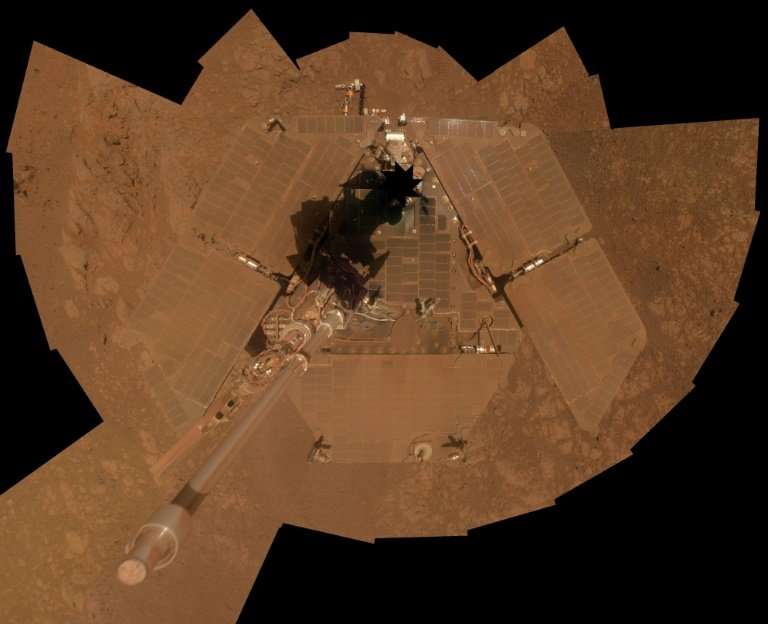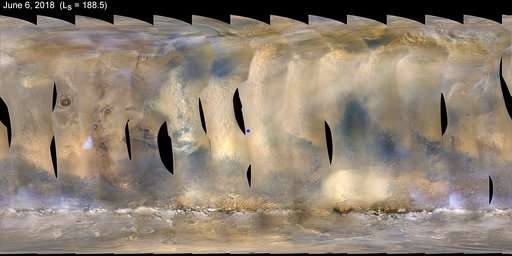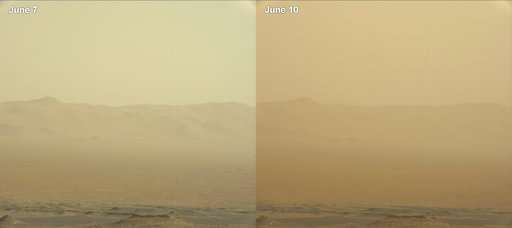Martian dust storm silences NASA's rover, Opportunity (Update)

A massive dust storm raging across Mars has overcome NASA's aging Opportunity rover, putting the unmanned, solar-powered vehicle into sleep mode and raising concerns about its survival, the US space agency said Wednesday.
The unusually severe dust storm has blocked out the Sun over one quarter of the Red Planet, blanketing an area spanning 14 million square miles (35 million square kilometers), NASA said.
Opportunity, located in a spot called Perseverance Valley, "has fallen asleep and is waiting out the storm," said John Callas, Opportunity project manager at NASA's Jet Propulsion Laboratory.
"We are concerned but we are hopeful that the storm will clear and the rover will be able to communicate with us."
The storm was first detected on May 30, and grew worse in recent days.
The robotic vehicle—one of two currently operating on Mars—has shut everything down except its master clock, and last communicated with Earth on June 10.
Callas declared a "spacecraft emergency" due to low power.
"In this point we are in a waiting mode. We are listening every day for possible signals from the rover," he said, likening the atmosphere among colleagues to having a loved one lying in a coma.
"If it was your 97-year-old grandmother, you would be very concerned. And we are," he said.

90-day mission
Opportunity, along with its twin named Spirit, launched in 2003 and landed on Mars a year later to hunt for signs of past life.
Its mission was initially meant to last just 90 days.
The rover "has made a number of discoveries about the Red Planet including dramatic evidence that long ago at least one area of Mars stayed wet for an extended period and that conditions could have been suitable for sustaining microbial life," NASA said in a statement.
When the storm struck, Opportunity was tooling around near a channel, carved in rim of crater, to see if it might have been created by flowing water, wind erosion, or something else.
Its partner rover, Spirit, became stuck in soft soil in 2009, and its mission was formally declared over in 2011.
Callas said he is hopeful Opportunity will not fully shut down because the approaching Martian summer means temperatures should not dip below the rover's minimal operating temperature, -55 degrees Celsius (-167 Fahrenheit).
The coldest NASA expects it to get is -36 C (-60 F).
"So we should be able to ride out the storm," he told reporters.
The dust is accumulating in a thin layer, and is not expected to bury the rover.

Opportunity is expected to remain asleep until there is enough power to charge the battery above a certain threshold, at which point it would autonomously wake up, said Callas.
Dust storms
Opportunity has traveled some 28 miles (45 kilometers) on the Martian surface. It survived a less severe dust storm in 2007.
Martian dust storms are more easily whipped up on the Red Planet than on Earth because of Mars' thin atmosphere.
They can last between a few weeks to a few months.
Where Opportunity lies, "it is completely black on Mars. It is completely dark," said Callas.
NASA's larger and newer Curiosity rover is on the other side of the planet, where the sky has already begun to darken from the storm.
However, NASA is not as worried about Curiosity, which landed in 2012, because it is nuclear-powered, not reliant on the Sun.
Experts said the dust storm is not likely to endanger NASA's InSight mission, which launched earlier this year and is scheduled to land in November, on a mission to study quakes on Mars.
But scientists are studying this and other dust storms on Mars in order to be better able to forecast them, in case human explorers ever set up camp there.
"We would not want to have a crew operating remotely from their base and be caught off guard with a storm like this and have difficulty getting back home," said Jim Watzin, director of the Mars Exploration Program at NASA.
© 2018 AFP





















